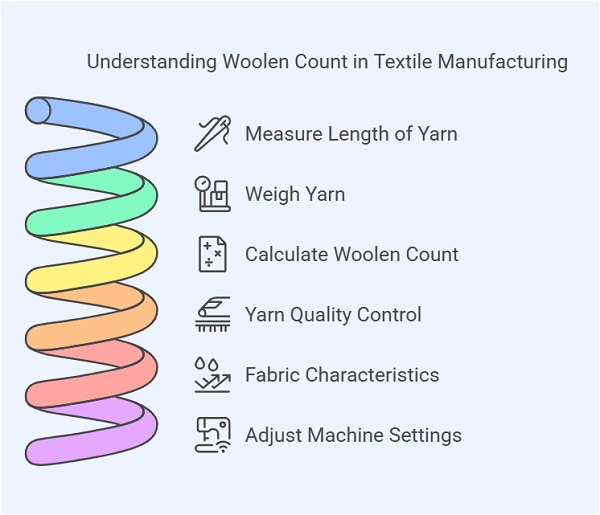Woolen Count (Yorkshire Skein)
© Yarn Count Ltd.
Disclaimer: All Tools in the Yarn Count have been reviewed by the relevant spinning industry experts.
© Yarn Count Ltd.
Disclaimer: All Tools in the Yarn Count have been reviewed by the relevant spinning industry experts.
The formula for Woolen Count (Yorkshire Skein) Calculator
Woolen Count=(Skeins per lb x 560) ÷ Length in yards)
Where:
Woolen count, also known as the Yorkshire skein, is a vital concept in textile manufacturing. It measures the fineness of woolen yarn. This unit is primarily used in the wool industry to determine the quality and weight of yarn produced. Woolen count refers to the number of hanks (or skeins) of yarn that can be spun from a pound of raw wool. The term “hank” refers to a specific length of yarn, which in the case of woolen count, is usually 560 yards. The woolen count system is unique to the UK and is used primarily in the Yorkshire region, hence the name Yorkshire skein.
A higher woolen count indicates finer yarn, whereas a lower count suggests coarser yarn. Understanding this count is essential for producing yarn with the desired characteristics for different applications, such as clothing or upholstery fabrics.

To calculate the woolen count, the formula is simple. You need to know the weight of the yarn in pounds and the length of the yarn in yards. The calculation can be broken down as follows:
For example, if you have 560 yards of wool yarn and the weight is 1 pound, the woolen count is 1. If you have 1,120 yards of yarn and it weighs 1 pound, the woolen count is 2.
Woolen count plays a significant role in the manufacturing process. Here are the primary reasons why it is important:
Several factors can influence the woolen count in textile production. These include:
Woolen count is particularly useful for:
The wool industry, particularly in regions like Yorkshire, has a long history of using the woolen count system. It allows textile manufacturers to standardize the production of woolen yarn. This standardization is essential for ensuring that the final product meets the required specifications.

To better understand woolen count calculation, let’s look at a few examples.
Example 1:
You have a skein of wool that measures 1,120 yards in length and weighs 1 pound. Using the formula, the woolen count is:
Woolen Count = (1,120 yards) / (1 pound) = 2
So, this yarn has a woolen count of 2.
Example 2:
If you have 840 yards of yarn weighing 0.5 pounds, the woolen count is:
Woolen Count = (840 yards) / (0.5 pounds) = 1.68
Thus, the woolen count is 1.68.
A woolen count calculator is a handy tool for textile engineers and manufacturers. It simplifies the process of calculating woolen count by automatically providing the result once the necessary data (yardage and weight) are entered. This tool saves time and reduces the chances of manual calculation errors.
With a woolen count calculator, manufacturers can quickly determine the quality of yarn they are working with and adjust their production processes accordingly.
To use the woolen count calculator effectively, follow these simple steps:
The woolen count (Yorkshire skein) is an essential measurement in textile manufacturing. It plays a critical role in ensuring the quality and consistency of yarn used in fabric production. By understanding and calculating woolen count, textile engineers can better control the yarn’s thickness, texture, and overall quality. Whether you are a textile manufacturer or an engineer, having a woolen count calculator at your disposal can streamline your workflow and improve production accuracy.